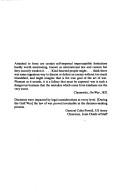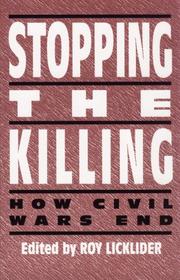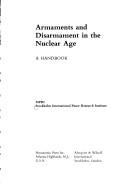| Listing 1 - 10 of 12 | << page >> |
Sort by
|
Book
ISBN: 081332467X Year: 1995 Publisher: Boulder, Colo. Westview Press
Abstract | Keywords | Export | Availability | Bookmark
 Loading...
Loading...Choose an application
- Reference Manager
- EndNote
- RefWorks (Direct export to RefWorks)
Polemology --- International law --- Armistices. --- War (International law) --- War (International law).

ISBN: 0719042046 0719035406 Year: 1993 Publisher: Manchester : Manchester University Press,
Abstract | Keywords | Export | Availability | Bookmark
 Loading...
Loading...Choose an application
- Reference Manager
- EndNote
- RefWorks (Direct export to RefWorks)
Book
ISBN: 9780521870887 0521870887 Year: 2010 Publisher: Cambridge Cambridge University Press
Abstract | Keywords | Export | Availability | Bookmark
 Loading...
Loading...Choose an application
- Reference Manager
- EndNote
- RefWorks (Direct export to RefWorks)
The Law of Armed Conflict: International Humanitarian Law introduces law students and undergraduates to the law of war in an age of terrorism. What law of armed conflict/international humanitarian law applies to particular armed conflicts? Does that law apply to terrorists as well? What is the status of participants in an armed conflict? What constitutes a war crime? What is a lawful target and how are targeting decisions made? What are rules of engagement? What weapons are lawful and unlawful, and why? This text takes the reader through these essential questions of the law of armed conflict and international humanitarian law to an awareness of finer points of battlefield law. The U.S.-weighted text incorporates lessons from many nations and includes hundreds of cases from jurisdictions worldwide.
War (International law) --- Humanitarian law --- Humanitarian law. --- Humanitarian conventions --- International humanitarian law --- Hostilities --- Neutrality --- War (International law). --- Aggression (International law) --- Targeted killing (International law) --- Drone aircraft --- Torture (International law) --- Cyberterrorism --- International law --- Law of armed conflicts. Humanitarian law --- War crimes
Book
ISBN: 9780198728504 0198728506 0191044156 0191044164 Year: 2016 Publisher: Oxford Oxford University Press
Abstract | Keywords | Export | Availability | Bookmark
 Loading...
Loading...Choose an application
- Reference Manager
- EndNote
- RefWorks (Direct export to RefWorks)
Bringing together the law of armed conflict governing the use of weapons into a single volume, the fully updated Second Edition of Weapons and the Law of Armed Conflict interprets these rules and discusses the factors influencing future developments in weapons law. After relating the historical evolution of weapons law, the book discusses the important customary principles that are the foundation of the subject, and provides a condensed account of the law that exists on the use of weapons. The treaties and customary rules applying to particular categories of weapon are thereafter listed and explained article by article and rule by rule in a series of chapters. Having stated the law as it is, the book then explores the way in which this dynamic field of international law develops in the light of various influences. The legal review of weapons is discussed, both from the perspective of how such reviews should be undertaken and how such a system should be established. Having stated the law as it is, the book then investigates the way in which this dynamic field of international law develops in the light of various influences. In the final chapter, the prospects for future rule change are considered.This Second Edition includes a discussion of new treaty law on expanding bullets, the arms trade, and norms in relation to biological and chemical weapons. It also analyses the International Manuals on air and missile warfare law and on cyber warfare law, the challenges posed by 'lethal autonomous weapon systems', and developments in the field of information and telecommunications otherwise known as cyber activities.
Book
ISBN: 9789185114566 Year: 2007 Publisher: Solna Stockholm International Peace Research Institute
Abstract | Keywords | Export | Availability | Bookmark
 Loading...
Loading...Choose an application
- Reference Manager
- EndNote
- RefWorks (Direct export to RefWorks)
Peaceful settlement of international disputes --- Polemology --- wapenhandel --- United Nations --- 874.1 Regelgeving en controle --- 822.1 Verenigde Naties --- Arms transfers --- Embargo --- Trade embargo --- Law and legislation --- Economic sanctions --- Sanctions (International law) --- Blockade --- War, Maritime (International law) --- War (International law)

ISBN: 0814765424 9780814765425 0814750702 9780814750971 0814750974 9780814750704 Year: 1993 Publisher: New York, NY : New York University Press,
Abstract | Keywords | Export | Availability | Bookmark
 Loading...
Loading...Choose an application
- Reference Manager
- EndNote
- RefWorks (Direct export to RefWorks)
Yugoslavia, Rwanda, Liberia, Somalia, Azerbaijan, El Salvador, Northern Ireland, Lebanon, Cambodia -- all provide bloody evidence that civil wars continue to have a powerful impact on the international scene. Because they tear at the very fabric of a society and pit countryman against countryman, civil wars are often the most brutal and difficult to extinguish -- witness the American Revolution. And yet, civil wars do inevitably end. England is no longer criss-crossed by warring armies representing York and Lancaster or King and Parliament. The French no longer kill one another over the divine right of kings. Argentines seem reconciled to living in a single state, rather than several. The ideologies of the Spanish Civil War now seem largely irrelevant. And the possibility of Southern secession is an issue long-buried in the American past. The question then begs itself: how do people who have been killing one another with considerable enthusiasm and success come together to form a common government? How can individuals and factions work together, politically and economically, with others who have killed their friends, parents, children and lovers? How are armed societies disarmed? What effect does a total military victory have on a lasting peace? In sum, how are civil societies constructed from civil violence and chaos? This is the central concern of Stopping the Killing.In this highly original and much needed volume, a distinguished group of experts on civil wars discuss both specific conflicts and broader theoretical issues. Individual chapters examine civil wars in Colombia, the Sudan, Yemen, America, Greece, and Nigeria, and analyze the causes of peace, the relationship between the battlefield and the negotiating table, and issues of settlement. An introduction and conclusion by the editor unify the volume. Contributors include: Jonathan Hartlyn (Univ. of North Carolina), Caroline Hartzell (Univ. of California, Davis), Jane E. Holl (U.S. Military Academy), John Iatrides (Southern Connecticut State University), James O'Connell (University of Bradford), Donald Rothchild (Univ. of California, Davis), Stephen John Stedman (Johns Hopkins Univ.), Robert Harrison Wagner (Univ. of Texas, Austin), Harvey Waterman (Rutgers Univ.), Manfred Wenner (Northern Illinois Univ.), and I. William Zartman (Johns Hopkins Univ.).
War (International law) --- Civil war. --- Hostilities --- International law --- Neutrality --- Civil wars --- Intra-state war --- Rebellions --- Government, Resistance to --- Revolutions --- War --- Civil war --- #SBIB:327.5H21 --- Vrede – oorlog, oorlogssituaties --- Polemology
Book

ISBN: 9780198791393 0198791399 019250892X 0192508911 Year: 2016 Publisher: Oxford : Oxford University Press,
Abstract | Keywords | Export | Availability | Bookmark
 Loading...
Loading...Choose an application
- Reference Manager
- EndNote
- RefWorks (Direct export to RefWorks)
"Although the relationship between international human rights law and the law of armed conflict has been the subject of significant recent academic discussion, there remains a lack of comprehensive guidance in identifying the law applicable to specific situations faced by military forces. Providing guidance for armed forces and practitioners on the detailed application of international human rights law during armed conflict, this book fills that gap. Part 1 of the volume details foundational information relating to international human rights law and human rights institutions, the types of operations that States' armed forces engage in, and how the law of armed conflict and international human rights law apply to regulate different situations. Part 2 provides practical guidance as to the legal regulation of specific situations, including discussion of the conduct of hostilities, detention operations, humanitarian assistance, cyber operations, and investigations." -- Publisher's website.
Théâtre de la guerre --- Forces armées --- Règles d'engagement (forces armées) --- Guerre (droit international) --- Humanitarian law --- Droit humanitaire --- Droits de l'homme --- Droit --- Règlement --- Règlement. --- Droit humanitaire. --- Droits de l'homme. --- Droit. --- Human rights. --- International law and human rights. --- War (International law). --- Human rights --- Polemology --- Règlements militaires --- Théâtre de la guerre --- Règlements militaires --- Règles d'engagement (forces armées)
Book
ISBN: 9780198723523 0198723520 Year: 2016 Publisher: Oxford, United Kingdom : Oxford University Press,
Abstract | Keywords | Export | Availability | Bookmark
 Loading...
Loading...Choose an application
- Reference Manager
- EndNote
- RefWorks (Direct export to RefWorks)
The United Nations Arms Trade Treaty became binding international law in late 2014, and although the text of the treaty is a relatively concise framework for assessing whether to authorize or deny proposed conventional weapons transfers by States Parties, there exists controversy as to the meaning of certain key provisions. Furthermore, the treaty requires a national regulatory body to authorize proposed transfers of conventional weapons covered by the treaty, but does not detail how such a body should be established and how it should effectively function. The Arms Trade Treaty: A Commentary explains in detail each of the treaty provisions, the parameters for prohibitions or the denial of transfers, international cooperation and assistance, and implementation obligations and mechanisms. As states ratify and implement the Treaty over the next few years, the commentary provides invaluable guidance to government officials, commentators, and scholars on the meaning of its contentious provisions. This volume describes in detail which weapons are covered by the treaty and explains the different forms of transfer that the Arms Trade Treaty regulates. It covers international human rights, trade, disarmament, humanitarian law, criminal law, and state-to-state use of force, as well as the application of the treaty to non-state actors.
wapenhandel --- Polemology --- Law of treaties --- Arms control --- Treaties --- Arms control. --- Treaties. --- Armement --- Traités --- Droit international --- Communauté internationale --- Sécurité internationale --- Armes --- Commerce international --- Contrôle --- Droit --- Industrie et commerce --- Ventes --- Réglementation --- Arms transfers --- Security, International --- Arms race --- Disarmament --- Military readiness --- War, Maritime (International law) --- War (International law) --- Law and legislation. --- Arms Trade Treaty --- Armements --- Law and legislation --- Vente --- Arms Trade Treaty (2013 June 3) --- ATT --- Traité sur le commerce des armes --- Tratado sobre el Comercio de Armas --- Contrôle --- Droit international. --- Communauté internationale. --- Sécurité internationale. --- Contrôle. --- Droit. --- Réglementation. --- Traités --- Communauté internationale. --- Sécurité internationale. --- Contrôle. --- Réglementation.

ISBN: 0391006525 9780391006522 Year: 1976 Publisher: Atlantic Highlands, N.J.: Humanities press,
Abstract | Keywords | Export | Availability | Bookmark
 Loading...
Loading...Choose an application
- Reference Manager
- EndNote
- RefWorks (Direct export to RefWorks)
chemische wapens --- ontwapening --- kernwapens --- wapenhandel --- biologische wapens --- Polemology --- Nuclear disarmament. --- Defense industries. --- Military readiness. --- War (International law) --- Defense industries --- Military readiness --- Nuclear disarmament --- 341.67 --- Hostilities --- International law --- Neutrality --- Atomic bomb and disarmament --- Atomic weapons and disarmament --- Disarmament, Nuclear --- Nuclear weapons disarmament --- Disarmament --- Antinuclear movement --- Nuclear weapons --- Armaments --- Defense readiness --- Defenses, National --- Military preparedness --- National defenses --- Preparedness (Military science) --- Readiness (Military science) --- Military policy --- Arms control --- Arms race --- Manpower --- Armaments industries --- Arms sales --- Military sales --- Military supplies industry --- Munitions --- Sale of military equipment --- Industries --- Arms transfers --- Ontwapening. Beperking ,vermindering van bewapening. Salt akkoorden. ABC akkoorden. Non-proliferatieverdragen. Oorlogspreventie --- 341.67 Ontwapening. Beperking ,vermindering van bewapening. Salt akkoorden. ABC akkoorden. Non-proliferatieverdragen. Oorlogspreventie
Book

ISBN: 9782804470098 2804470091 Year: 2015 Volume: *2 Publisher: Brussel Larcier
Abstract | Keywords | Export | Availability | Bookmark
 Loading...
Loading...Choose an application
- Reference Manager
- EndNote
- RefWorks (Direct export to RefWorks)
This annotated Code on Weapons and international law gives a thorough legal and practical analysis of this important new legal instrument to regulate the global trade of the most commonly used weapons.
Polemology --- wapenhandel --- Law of armed conflicts. Humanitarian law --- Law of treaties --- Arms transfers --- Arms control. --- Armes --- Armements --- Law and legislation. --- Vente --- Droit --- Contrôle --- Arms Trade Treaty --- Security, International --- Arms race --- Disarmament --- Military readiness --- War, Maritime (International law) --- War (International law) --- War (International law)Law and legislation.Arms Trade Treaty --- ATT --- Arms Trade Treaty (2013 June 3) --- Arms control --- Limitation des armements --- Nations Unies. Traité sur le commerce des armes (3 juin 2013) --- Nações Unidas. Tratado de Comércio de Armas Convencionais (3 junho 2013) --- TCA --- TCAC --- Traité sur le commerce des armes (3 juin 2013) --- Tratado de Comércio de Armas Convencionais (3 junho 2013) --- Tratado sobre el Comercio de Armas (3 junio 2013) --- United Nations. Arms Trade Treaty (2013 June 3) --- Unión Europea. Tratado sobre el Comercio de Armas (3 junio 2013) --- VN-Wapenhandelsverdrag (3 juni 2013) --- Vereinten Nationen. Vertrag über den Waffenhandel (3. Juni 2013) --- Verenigde Naties Wapenhandelsverdrag (3 juni 2013) --- Vertrag über den Waffenhandel (3. Juni 2013) --- Wapenbeheersing --- Traité sur le commerce des armes --- Tratado sobre el Comercio de Armas --- Contrôle --- Law and legislation
| Listing 1 - 10 of 12 | << page >> |
Sort by
|

 Search
Search Feedback
Feedback About
About Help
Help News
News